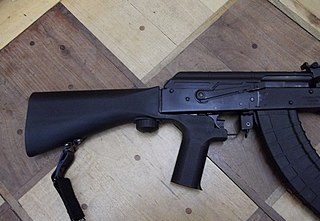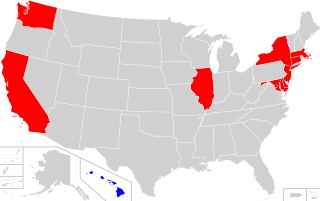
A firearm is any type of gun that uses an explosive charge and is designed to be readily carried and used by an individual. The term is legally defined further in different countries.

A muzzle brake or recoil compensator is a device connected to, or a feature integral to the construction of, the muzzle or barrel of a firearm or cannon that is intended to redirect a portion of propellant gases to counter recoil and unwanted muzzle rise. Barrels with an integral muzzle brake are often said to be ported.

In the United States, assault weapon is a controversial term applied to different kinds of firearms. There is no clear, consistent definition. It can include semi-automatic firearms with a detachable magazine, a pistol grip, and sometimes other features, such as a vertical forward grip, flash suppressor, or barrel shroud. Certain firearms are specified by name in some laws that restrict assault weapons. When the now-defunct Federal Assault Weapons Ban was passed in 1994, the U.S. Department of Justice said, "In general, assault weapons are semiautomatic firearms with a large magazine of ammunition that were designed and configured for rapid fire and combat use." The commonly used definitions of assault weapons are under frequent debate, and have changed over time.

The National Firearms Act (NFA), 73rd Congress, Sess. 2, ch. 757, 48 Stat. 1236 was enacted on June 26, 1934, and currently codified and amended as I.R.C. ch. 53. The law is an Act of Congress in the United States that, in general, imposes an excise tax on the manufacture and transfer of certain firearms and mandates the registration of those firearms. The NFA is also referred to as Title II of the federal firearms laws, with the Gun Control Act of 1968 ("GCA") as Title I.

In firearms terminology and at law, the firearm frame or receiver is the part of a firearm which integrates other components by providing housing for internal action components such as the hammer, bolt or breechblock, firing pin and extractor, and has threaded interfaces for externally attaching ("receiving") components such as the barrel, stock, trigger mechanism and iron/optical sights.

An automatic firearm or fully automatic firearm is a self-loading firearm that continuously chambers and fires rounds when the trigger mechanism is actuated. The action of an automatic firearm is capable of harvesting the excess energy released from a previous discharge to feed a new ammunition round into the chamber, and then igniting the propellant and discharging the projectile by delivering a hammer or striker impact on the primer.
A hell-fire trigger is a device that allows a semi-automatic firearm to fire at an increased rate. The hell-fire clamps to the trigger guard behind the trigger and presses a "finger" against the back of the trigger to increase the force that returns the trigger to its forward position, effectively decreasing the time required for the trigger to reset, allowing for a faster follow up shot.

A firearm is said to fire from an open bolt or open breech if, when ready to fire, the bolt and working parts are held to the rear of the receiver, with no round in the chamber. When the trigger is actuated, the bolt travels forward, feeds a cartridge from the magazine or belt into the chamber, and fires that cartridge in the same movement. Like any other self-loading design, the action is cycled by the energy released from the propellant, which sends the bolt back to the rear, compressing the mainspring in readiness for firing the next round. In an open-bolt gun firing semi-automatically, the bolt is caught and held at this point by the sear after each shot; and in automatic open-bolt fire, it's caught and held in this manner whenever the trigger is released. In contrast to this, in closed-bolt guns, the trigger and sear do not affect the movement of the bolt directly.

The Firearm Owners' Protection Act (FOPA) of 1986 is a United States federal law that revised many provisions of the Gun Control Act of 1968.
A Federal Firearms License (FFL) is a license in the United States that enables an individual or a company to engage in a business pertaining to the manufacture or importation of firearms and ammunition, or the interstate and intrastate sale of firearms. Holding an FFL to engage in certain such activities has been a legal requirement within the United States since the enactment of the Gun Control Act of 1968. The FFL is issued by the Bureau of Alcohol, Tobacco, Firearms, and Explosives

Bump stocks or bump fire stocks are gun stocks that can be used to assist in bump firing, the act of using the recoil of a semi-automatic firearm to fire ammunition cartridges in rapid succession.
In the United States, the right to keep and bear arms is modulated by a variety of state and federal statutes. These laws generally regulate the manufacture, trade, possession, transfer, record keeping, transport, and destruction of firearms, ammunition, and firearms accessories. They are enforced by state, local and the federal agencies which include the Bureau of Alcohol, Tobacco, Firearms and Explosives (ATF).

Title II weapons, or NFA firearms, are designations of certain weapons under the United States National Firearms Act (NFA).

The Public Safety and Recreational Firearms Use Protection Act, popularly known as the Federal Assault Weapons Ban, was a subsection of the Violent Crime Control and Law Enforcement Act of 1994, a United States federal law which included a prohibition on the manufacture for civilian use of certain semi-automatic firearms that were defined as assault weapons as well as certain ammunition magazines that were defined as large capacity.

Assault weapons legislation in the United States refers to bills and laws that define and restrict or make illegal the manufacture, transfer, and possession of assault weapons. How these firearms are defined and regulated varies from jurisdiction to jurisdiction; generally, this constitutes a list of specific firearms and combinations of features on semiautomatic firearms.

The S333 Thunderstruck is an aluminum-frame revolver designed and manufactured by Standard Manufacturing of New Britain, Connecticut. Introduced in 2019 and intended for concealed carry, is notable for being a volley gun, as each pull of the trigger simultaneously fires two .22 Winchester Magnum Rimfire cartridges.

A privately made firearm is a legal term for a firearm produced by a private individual as opposed to a corporate or government entity. The term "ghost gun" is used mostly in the United States by gun control advocates, but it is being adopted by gun rights advocates and the firearm industry because of recent regulations adopted by the Bureau of Alcohol, Tobacco, Firearms and Explosives.

A switch or Glock auto-sear is a small device that can be attached to the rear of the slide of a Glock handgun, converting the semi-automatic pistol into a machine pistol capable of fully automatic fire. As a type of auto sear, it functions by applying force to the trigger bar to prevent it from limiting fire to one round of ammunition per trigger pull. This device by itself, regardless if it is installed on a slide or not, is considered by the Bureau of Alcohol, Tobacco, Firearms and Explosives (ATF) to be a machine gun, making possession of the device illegal in the United States under most circumstances.
Garland v. Cargill,, is a pending United States Supreme Court case regarding bump stocks. The court will decide whether bump stocks are "machineguns" as defined by Title 26 of the United States Code.
A binary trigger is a device that allows a semi-automatic firearm to fire at an increased rate. The binary trigger works by firing one shot upon pulling the trigger and then firing a subsequent shot upon release of the trigger.












